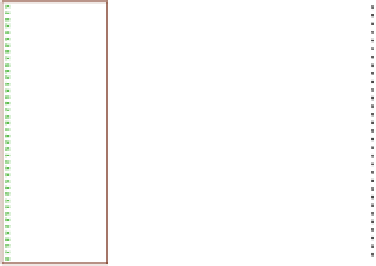Geoscience Reference
In-Depth Information
problem. In this equation,
denotes the 2.5D resistivity
model (vector of model parameters; note that we esti-
mate the log-conductivity distribution to enforce positiv-
ity of the resistivity of each cell),
X
Scanning points
Seismoelectric image
×
(m)
×
(m)
0
200
400
0
200
400
0
0
X
0
can represent a prior
resistivity model (we will not use such a prior hereinaf-
ter);
is the nonlinear forward operator used to map
the predicted data, given a resistivity model;
G
200
200
signifies
the vector of measured apparent resistivity (measured
data vector),
X
,
d
C
−
d
stands for the data covariance matrix
(taken diagonal and based on the variance on the mea-
surements);
400
400
designates the regularization parameter
that balances the data misfit function and the model
objective function, and
β
600
600
C
−
m
symbolizes the smoothing
matrix. In the classical least-square inversion,
C
−
m
is a
square
n
×
n
matrix corresponding to the Laplacian oper-
ator of the model (
n
denotes the number of cells). The
classical inversion of the apparent resistivity data with
no structural information (isotropic smoothness) is
shown in Figure 6.23. We see that this approach yields
a very smooth resistivity image because of the lack of res-
olution of the resistivity method far from the electrodes.
In addition, the true values of the electrical resistivity are
not recovered very well.
The question now is to see what would be the effect
of incorporating into the resistivity data the structural
information contained in the seismoelectric image. Since
we are able to identify the boundaries with the seismo-
electric focusing approach, we assign weights to the
neighbors of a pixel only if they belong to the same mate-
rial property unit (Figure 6.24). This way, we directly
incorporate structural information into the objective
function by changing only the matrix
800
800
1000
1000
(a)
(b)
Figure 6.20
Seismoelectric image of the electrical potential
using a set of electrodes located in the two wells for the domain
ℜ
.
a)
Position of the scanning (focusing) points. The total
number of scanning points is actually (
N
x
= 128) × (
N
z
= 320),
that is, a total of more than 40,960 points. Only a fraction of
these points is shown here.
b)
High-definition voltage map
with the position of the electrodes used in the wells to scan
the electrical potential. We see that the voltage map contains
a lot of structural information regarding the position of the
heterogeneities between the wells in the scanning area. The
voltages are opposite in sign on each side of the heterogeneities.
(
See insert for color representation of the figure
.)
C
−
m
. A detailed
approach on how this structural information is incorpo-
rated in
measurement electrode in each borehole) with a total of
19,292 measurements.
The next step is to invert these apparent resistivity
data. In electrical impedance (resistivity) tomography,
we traditionally use a least-square minimization of the
following objective function,
P
β
(
C
−
m
can be found in a number of papers (e.g.,
Farquharson, 2008; Hale, 2009a, b, c; Lelièvre & Farqu-
harson, 2013; Zhou et al., 2014).
), using the L2 norm
to find an optimal resistivity model,
X
6.3.2.3 Results
In the following, we study the effect of the structural infor-
mation on the recovered model. The L-curve method can
be used, in principle, to find the optimal value of the
regularization parameters. In our approach, we enforce
structural information; therefore, finding a value with
an L-curve may not necessarily be the optimal way to
proceed. For our tests, we considered the following values
of the regularization parameter
∗
:
X
X
∗
= arg min
P
β
X
,
6 1
T
β
X
−
X
0
T
P
β
X
C
−
d
G
C
−
m
X
−
X
0
,
6 2
=
G
X
−
d
X
−
d
+
where
P
β
(
) is the sum of a data misfit function (first
term) and a model objective function (second term),
which is used for the regularization of
X
: 0.1 (light), 1 (medium),
10 (hard), and 100 (extreme) (see Figure 6.25). A typical
β
the inverse






















































